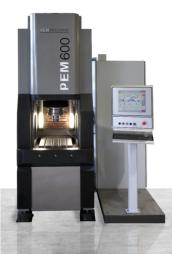Metal Processing
Headlines

Precision electrochemical machining: a credible alternative
Precision electrochemical machining (PECM) has shown its efficiency, as noted in the study conducted by Cetim. In order to assist SMEs from the mechanical industry with feasibility studies and help them to get familiar with this technology, the centre has purchased a new machine: Pemtec’s PEM 600. Here are a few explanations.
Further to the characterisation action carried out in the scope of the study concerning the validation of innovative solutions, the industrialists who belong to Cetim’s mould makers’ commission wished to accurately assess Pemtec’s electrochemical machining process on production mould prints. The main requirements assessed were accuracy, surface condition and costs.
Precision electrochemical machining (PECM) is based on the dissolution of a polarised metallic material used as an anode (positive) in an electrically conductive medium. An electrolysis with ionic dissolution of the anode (the workpiece) then occurs of each electrical impulse. No material is removed from the cathode (the electrode) but hydrogen gas is formed. The operation is contactless and does not involve any thermal effect.
According to the conclusion of this study (performance report 9Q236) conducted on various materials, vibration and pulsed current electrochemical machining with a regulated gap is not devoid of interest and offers interesting prospects for the manufacturing of some specific mould prints and very hard and accurate tools, for cold heading, for instance. “The results obtained are very good, in terms of quality (accuracy), manufacturing time (speed and time) and manufacturing cost”, explains Stéphane Guérin from Cetim.
Accordingly, precision electromechanical machining (PECM) can be an interesting alternative to sinker electrical discharge machining (EDM). This solution becomes competitive for tool manufacturing if the electrode and the tools are amortised over large series. In addition, the surface condition is of good quality and polishing operations can be significantly reduced while increasing the tool’s service life.
In addition to the abovementioned points, almost all metals can be processed by electrochemical machining, without hardness limits. Due to the heterolysis of the material, there is no thermal effect on the machined metallic structure (no micro-cracks, no white surface and no mechanical stresses).
As a consequence, many industrial sectors will be concerned by this technology: the automobile sector (possibility to suppress burrs), the aerospace industry (machining difficult materials whilst preserving material integrity) and the medical sector in which very good surface conditions will be directly obtained. “There are many other applications to be investigated and discovered, such as surface texturisation”, adds Stéphane Guérin.
Pemtec’s PEM600
In order to help companies with feasibility studies and to become familiar with this new technology, Cetim has purchased a PEM 600 machine from Pemtec. The process designed by the Pemtec company includes a vibrating electrode, a regulated “gap” and a pulsed direct current between the electrode and the workpiece to be machined.
Advantages: as the machine temperature ranges between 20 °C and 50 °C, there are no thermal effects on the material (no micro-cracks, no whitening, no burrs, etc.). The machining speed can range between a few microns for polishing to 2 mm/min for rough machining, irrespective of the surface to be machined. The material removal rate is irrespective of the material’s hardness and resistance. Roughness can reach very low values (Ra). Rough machining, finishing and polishing are carried out during a single operation.
The machine offers a workspace of 590 * 740 mm. The maximum surface machinable in one operation is 100 cm 2. The oscillation frequency of the anode ranges between 10 and 60 Hz. The triggering of the very short pulse requires an electric pulse generator with a very high power (1,200 to 9,600 A).
Other informations
A whole week of testing for future training technologies
Headlines
From 22 to 26 March 2021, new learning tools were assessed under real conditions in the Hauts-d...
Video: Cetim takes up the challenge of metal additive manufacturing
Headlines
In a new video, Philippe Lubineau, Chief Research Officer at Cetim, talks about this key techno...
Video: “I am Sure” project monitors metal additive manufacturing
Headlines
detection of incipient defects reveals its results in a new video. The “I am Su...
Scientific publications
- Galling detection by acoustic emission according to ASTMG98
- Thermomechanichal study of high speed rolling element bearing: a simplified approach
- Robust Active Control of The Milling Process Vibrations in a fixed reference frame
- 3D numerical simulation of drilling residual stresses
- Influence of the lubrication conditions on surface integrity in drilling
References
Fault analyses completed in double quick time
( Locapal)Test protocols tailored to each implant
( Newclip Technics)Acceptance of a key Vulcain 2.1 engine component
( ArianeGroup)Assistance in automated polishing
( Chapuis Armes)Better characterize the powders to better use them
( Chpolansky)Results of studies
ASME Boiler and Pressure Vessel - Code Week Meetings - November 2019 - Version Anglaise
Dimensioning of form tapping – Phase 3
Feasibility study of the multi-directional forging technology - PHASE 2
Material fatigue - Factors influencing the fatigue strength of metal of metal materials
Additive manufacturing of hot-forging tooling
Presentation
Deeply touched by crisis, this industry can rely on the various skills offered by Cetim to reinforce its competitiveness.
Innovation, product ranges redesign, process or organizational expertise... Cetim suggests you alternative solutions and takes part in supporting this essential-to-the-industrial-production market.





